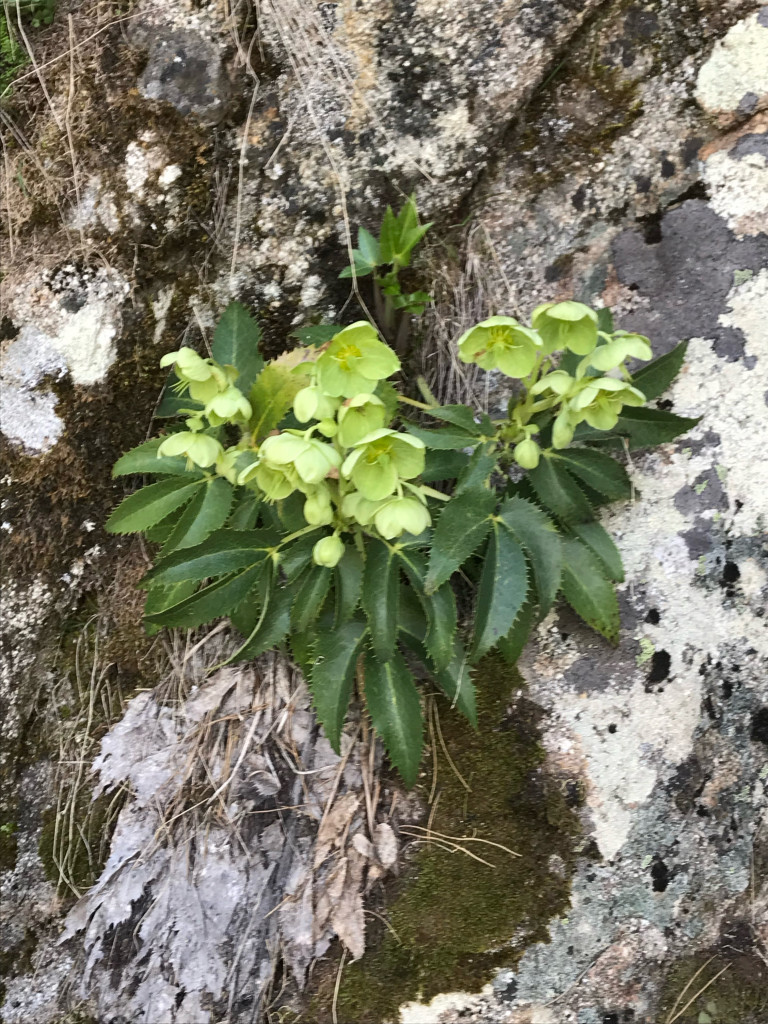It’s a complete mystery to me why, of 100,000+ photos of plants in my photo library, I don’t have a single decent pic of Helleborus argutifolius. It more than merits tens, if not hundreds of pics.
Helleborus argutifolius isn’t like most other hellebores. It’s the best known of a small group of species known as the caulescent (stemmed) species that grow upright leaf-bearing stems (while in most other species the leaves emerge individually from ground-level, or underground stems), which terminate in a great cluster of flowers.

Unlike the better known and more florally diverse Helleborus x hybridus (more on them here), Helleborus argutifolius could be grown for its foliage alone, making a great shrub-like mound of leathery, mid-green (and sometimes slightly sage-green) leaves divided into three leaflets, and usually toothed around the edges with benign spines. In winter, each of these stems produces a branched head of Granny-Smith-apple-green flowers, like a great bunch of grapes, with far greater generosity than your average hybrid hellebore.
During flowering, new shoots arise from the base of the plant that will carry the following season’s leaves and the next winter’s flowers. So once the current year’s stems look truly spent (and they go on making a contribution for a very long time), they can be cut right to the ground, leaving the new stems that quickly fill out to replace the old. They’re one of those rare herbaceous plants that really don’t have a downtime.

But better still, Helleborus argutifolius is much more sun and drought tolerant than your average hybrid hellebore, speaking of their Corsican and Sardinian origins. Having said that, Australian gardeners tend to place them in similar shady conditions to the hybrids, in which they flower very well but tend to flop badly. I once used them on a very sunny bank tumbling down to large areas of hot paving surrounding a pool in Templestowe, and I’ve never seen them perform better. The rather shorter stems, due to the challenging conditions, were entirely self-supporting. But that’s the sum total of my experience testing their tolerance. That’s where you guys all come in! Has anyone tested their sun, heat and/or drought tolerance? We need to hear! Please comment below.

I have had this tough little nut in my garden for many years, and appreciate its winter flowering. It’s usually in the shadier parts of the garden where it flops over in flower. It’s a generous seeder and is easily renewed. In the last few years it’s chosen to self seed and grow well in sunnier spots in the garden. I’m leaving it because it’s found suitable companions so far. I’ll have to to keep you posted on its survive/thrive virtues in its hotter spots!
Looking forward to hearing, Annette. I can imagine it surviving pretty well in full sun here, and only really hating the hottest of days. That being the case, the question will be in what state it emerges from those hot days – whether it’s burnt or otherwise damaged in such a way as to compromise its foliage contribution. Your summers will be harder again, so I’ll be keen for a report!
I grow it in an area that’s shady for most of the day/year but get’s a 2-3hr blast of hot afternoon sun in summer. It’s one of the few plants I’ve found that handles the shade for most of the day, but doesn’t burn when the hot summer afternoon sun bears down on it. I’m also on terrible sandy soil and it doesn’t care. It looks great all year and the flower bracts last for 6 months.
That’s such great info, Renata. There are so few plants that can stand that episodic blast of summer sun. And so good to know that it doesn’t mind the sandy soil
I had it growing in very dry conditions under a golden elm. It never wilted or flopped and always looked great, whatever the weather. Will be interested to see how it copes in hot sun, makes sense that it would considering it’s origin.
Yes, it would make sense. Certainly it says something about its drought tolerance, though whether it hides under other stuff, or on the shady side of a rocky crag (which Stephen Ryan’s photo might suggest) is yet to be seen. But great to know that it coped with the extremely competitive conditions of both low (though seasonally low) light, and root ridden soil, under a golden elm.
The most widely grown hellebores are shade lovers .Perhaps we have assumed H.argutifolius is too , inapproriately so. I have never had much luck transplanting mature H.foetidus or H.argutifolius so I will grow some from seed and try them in sunnier spots
I’ll do the same. Let’s see what happens